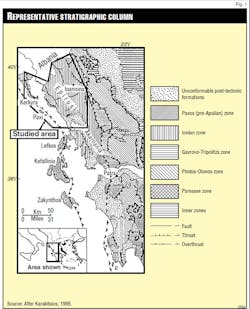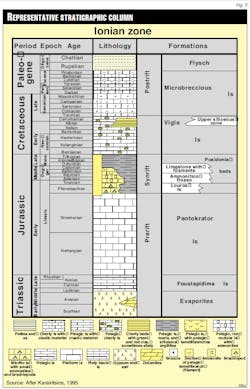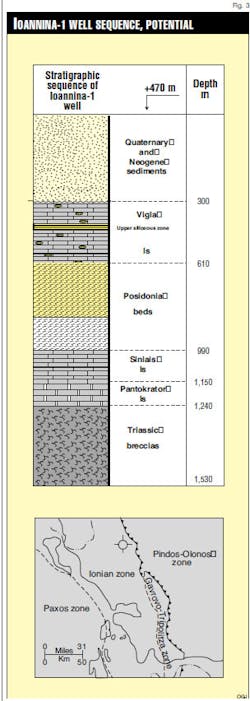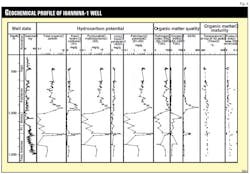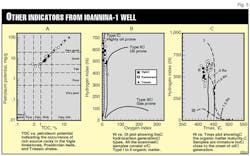Vassilis Karakitsios University of Athens Athens
Nickos Rigakis Public Petroleum Corp. Athens
The Ionian zone of Northwest Greece (Epirus region) constitutes part of the most external zones of the Hellenides (Paxos zone, Ionian zone, Gavrovo Tripolitza zone (Fig. 1). The rocks of the Ionian zone range from Triassic evaporites and associated breccias through a varied series of Jurassic through Upper Eocene carbonates and lesser cherts and shales followed by Oligocene flysch (Fig. 2).
The surface occurrences of petroleum in the Ionian zone are mainly attributed to Toarcian Lower Posidonia beds source rocks and lesser to late Callovian-Tithonian Upper Posidonia beds and to the Albian-Cenomanian Upper Siliceous zone or “Vigla shales” of the Vigla limestones.1-5
Oil that could not be attributed to the above source rocks is believed to have an origin from Triassic formations that contain potential source rocks in Albania and Italy.4 However, several samples of the shales of Triassic breccias from outcrops and drillholes were analyzed in the past, but the analytical results were not so promising since their hydrocarbon potential was low.
In this article, we will present our analytical results of the Ioannina-1 well (Fig. 3), where for the first time we identified some very rich source beds in the Triassic breccias formation of Northwest Greece.
Hydrocarbon potential
The stratigraphic se- quence in the Ioannina-1 borehole (Fig. 3), determined from cuttings and cores, is as follows:5
- 0-300 m, Quaternary and Neogene sediments.
- 300-610 m, Vigla limestones.
- 610-990 m, nondifferentiated Posidonia beds.
- 990-1,150 m, Siniais limestones.
- 1,240-1,530 m, Triassic breccias.
Because the Pantokrator limestones are generally more than 1,000 m thick, the contact between Pantokrator limestones and underlying breccias might be tectonic.
The hydrocarbon potential of all the formations drilled by the Ioannina-1 well was determined from RockEval data. All these data are plotted in relation with depth and with the gamma ray log of this well (Fig. 4). Several horizons of possible source rocks have been identified from this study.
1. The “Vigla shales” at 460-485 m have a TOC of 1.44-2.44% (Figs. 4, 5a) and Type I to II organic matter (Fig. 5b).
2. The Posidonia shales or Posidonia beds, which constitute the main source rock horizon of Central and External Ionian zone, with a TOC content ranging from 1.05-3.46% (average 1.60%), with two extreme high values—1.05% at 910 m depth and 9.82% at 940 m (Figs. 4, 5a). Their organic matter is also of Type I and II (Fig. 5b), highly oil prone.
3. The shales of Triassic breccias. In the Ioannina-1 well, we identified some very rich source beds in that formation. The analysis of a pure shale fragment from a core at 1,250 m indicated a very high TOC content, up to 11.15%. The corresponding petroleum potential value is also extremely high, reaching 74.02 mg HC/g of rock.
The organic matter of this sample is also of very good quality, having a hydrogen index of 662 and an oxygen index of 4. These indexes characterize a Type I organic matter, highly oil prone. Further, we analyzed more samples, handpicked shale fragments, from the interval below 1,250 m. These analyses showed the presence of rich source rocks in the interval 1,250-70 m (Figs. 3, 4, and 5a). As the area of the well is highly deformed,5 this thickness is not representative of the real thickness of the rich source horizons.
Maturity
Several parameters have been examined for predicting the thermal maturity of the possible source rocks of the Ioannina-1 well, such as vitrinite reflectance (Ro), spore coloration as expressed from the thermal alteration index (TAI), and three of the parameters obtained from the RockEval pyrolysis Tmax, PI, and HI. Each of these paramaters indicates the immaturity of the organic matter.
For better prediction of the maturity we used a crossplot of HI to Tmax (Fig. 5c). This diagram shows that the organic matter has an equivalent Ro value less than 0.5%, which indicates that it is immature for oil generation at the well position. On the other hand, the good quality of the organic matter (Type I or II) for all the possible source rocks is confirmed.
Oil source correlation
The main question that arose after the identification of possible sources in the Triassic breccias was whether these shale fragments are indigenous, of Triassic age, or are fragments of Posidonia shales tectonically mixed in the Triassic breccias. Geochemistry gave the answer. For that purpose, two characteristic samples, one from Triassic shales at 1,250 m and another from Posidonia shales at 945 m of the Ioannina-1 well, were analyzed in terms of stable carbon isotopes (δ13C) of saturates and aromatics determination and special biomarkers of sterane and terpane group identification.
The carbon isotopic data of saturated and aromatic hydrocarbons do not differ significantly. Values of δ13C of saturated hydrocarbons from both samples are exactly the same, –28.86. Values of aromatic hydrocarbons show unimportant differences: Triassic –28.20, Posidonian –29.95. These results do not differentiate the examined samples.
On the other hand, critical differences appeared in characteristic biomarker compounds:
1. The compounds pregnane and bisnorcholane are very high in the Triassic shale, almost twice as large as the C29 steranes, while in the Posidonia shale these compounds are just one fourth of the C29 steranes. This high pregnane could indicate an evaporitic depositional environment of the Triassic shales.6
2. The diasteranes are almost absent in the Triassic shale, indicating the absence of any terrigenous input in this sample.6
3. Triassic shale shows a very high peak of the C30 sterane. This is also a characteristic compound that is almost absent in all the other formations of the Epirus area and is only present in this Triassic shale. It is an indicator of a marine depositional environment.7
4. In the terpane fragmentogram, the gammacerane is one of the major compounds of the Triassic shale, while in Posidonia shale it is almost absent. Gammacerane is generally low in all the analyzed source rocks and oil shows in the area. This high gamma- cerane peak is also an indicator of an evaporitic environment.7 8
Besides these critical differences, Triassic shale differs significantly in the very low ratio of C24 tetracyclic terpane to C23 tricyclic terpane, which is unusual for the area.9
All the observations noted above definitely characterize a different type of organic matter for the shale fragments in the Triassic breccias. These shale fragments cannot be originated from the Posidonia formation. It is a new source rock horizon, possibly deposited inside the Triassic evaporite sequence. None of the analyzed oils in western Greece show similar characteristics with that type of oil. Obviously most of the oil produced from this source rock is trapped under the Triassic evaporites.
Acknowledgment
We thank DEP-EKY for performing the analytical work.
References
1. Institut de Geologie et Recherches du Sous-sol-Institut Francais du Petrole, Etude geologique de l’Epire (Grece nord-occidentale); Editions Technip, Paris, 1966, 306 p.
2. Nikolaou, C., Contribution to the knowledge of the Neogene, the geology and the Ionian and pre-Apulian limits in relation to the petroleum geology observations in Strophades, Zakynthos, and Kephalynia islands, doctoral thesis (in Greek), University of Athens, 1986, 228 p.
3. Baudin, F., and Lachkar, G., Geochmimie organique et palynologie du Lias superieur en zone ionienne (Grece), exemple d’une sedimentation anoxique conservee dans une paleomarge en distension, Bull. Soc. Geol. France, Vol. 8, t. VI, No. 1, 1990, pp. 123-132.
4. Roussos, N., and Marnelis, P., Greece licensing round to focus on western sedimentary basins, OGJ, Mar. 6, 1995, pp. 58-62.
5. Karakitsios, V., The influence of pre-existing structure and halokinesis on organic matter preservation and thrust system evolution in the Ionian basin, Northwest Greece, AAPG Bull., Vol. 79, 1995, pp. 960-980.
6. Peters, K.E., and Moldowan, J.M., The biomarker guide: Interpreting molecular fossils in petroleum and ancient sediments, Prentice Hall eds., New Jersey, 1993, 363 p.
7. Moldowan, J.M., Seifert, W.K., and Gallegos, E.J., Relationship between petroleum composition and depositional environment of petroleum source rocks, AAPG Bull., Vol. 69, 1985, pp. 1,255-68.
8. Powell, T.G., Petroleum geochemistry and depositional setting of lacustrine source rocks, Marine and Petroleum Geology, Vol. 3, 1983, pp. 200-219.
9. Palacas, J.G., Monopolis, D., Nicolaou, C.A., and Anders, D.E., Geochemical correlation of surface and subsurface oils, western Greece, in Leythaeuser, D., and Rullkotter, J., eds., Advances in organic geochemistry 1985: Organic geochemistry, Vol. 10, 1986, pp. 417-423.
The Authors
Vassilis Karakitsios is associate professor in the Department of Geology, National University of Athens. His professional experience includes stratigraphy and tectonics of continental collision zones of the eastern Mediterranean and basin analysis of the external Hellenides. He has a diploma in geology from National University of Athens, an MS and PhD in structural geology, and a PhD in earth sciences from P. et M. Curie University.
Nickos Rigakis is geochemist and head of laboratory department of Public Petroleum Corp. of Greece–EKY (DEP-EKY). He worked 15 years in DEP-EKY’s exploration department as geochemist. He has studied geology at the University of Thessaloniki.
